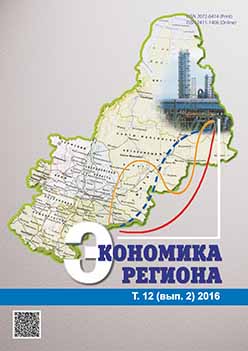Оценка и прогноз пространственной конфигурации валового продукта регионов России
Gross Regional Product of Russian Regions in Last Years: Dynamic and Spatial Configuration
Author(s): Boris Leonidovich Lavrovsky, Evgeny Aleksandrovich ShiltsinSubject(s): Economy, Geography, Regional studies
Published by: Институт экономики Уральского отделения Российской академии наук
Keywords: spatial configuration; convergence-divergence of regional space; regional differentiation; economic growth; distribution dynamics; coefficient of variation; GRP; Russian regions;
Summary/Abstract: The relation between regional and macroeconomic growth in Russia for the period of 1990 — 2013 are considered in thepaper. The purpose is to estimate this ratio depending on the phase (stage) of development. The hypothesis is that the increase inregional disparities within the post-Soviet period picked up by standard measures and noted in the literature, is not associatedwith the systemic removal of regional indicators from each other. The specific forms of convergence-divergence are typical for theRussian regional space and they have to be identified. The dynamics of regional space configuration in Russia is considered froma new perspective — as a mass distribution of the gross domestic product of regions by the value of growth rates. The estimationand forecast of the structural characteristics of the gross regional product (GRP) mass distribution are made on the basis ofthe “distribution dynamics” approach up to 2025. The average annual growth in 2025 is expected at around 104.5 %, whilegrowth differentiation significantly increases. The phase of macroeconomic growth for the last 15 years is reflected in its regionalcomponents. The GRP growth in Russia in general, both before and after the crisis of 2009, forms a more dense distributionthan in 2009. The general trend of the 2000th and subsequent years is characterized by a certain decline in per capita GRPdifferentiation in relation to the main regional space (74 regions). The results of this paper may be useful for regional regulationpolicy purposes. A set of the Russian regions in the years of 2009–2013, against to the dominant tendency, provides a dynamics,that can be compared to the number of countries with a developed market. There is an urgent need to create a special researchproject to study this phenomenon
Journal: Экономика региона
- Issue Year: 12/2016
- Issue No: 2
- Page Range: 383-395
- Page Count: 13
- Language: Russian

